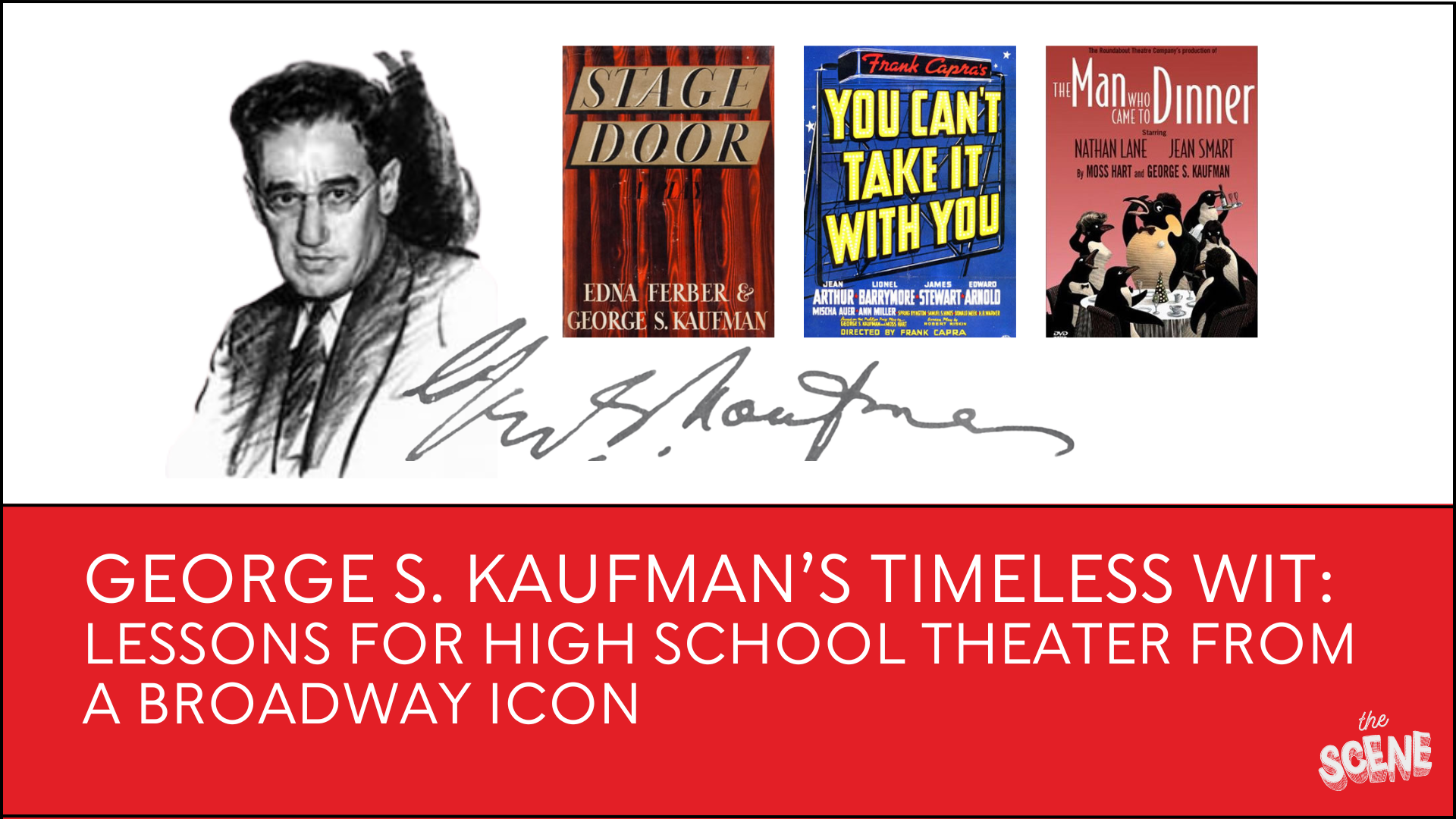By Zach Dulli, The Scene
George S. Kaufman, one of Broadway’s most celebrated playwrights, left behind a body of work that continues to inspire performers and audiences nearly a century later. Known for his sharp wit, masterful comedic timing, and keen observation of human nature, Kaufman’s plays remain a fixture in American theater. For high school theater directors and students, his works provide a unique opportunity to delve into the humor, humanity, and craftsmanship that define great storytelling.
Laurence Maslon, an esteemed musical theater historian and arts professor at NYU’s Tisch School of the Arts, has a deep connection to George S. Kaufman’s legacy through his role as co-executor of the Kaufman estate with actor David Pittu. In a recent conversation with The Scene, he shared insights into why Kaufman’s humor remains timeless and how his works continue to captivate and inspire high school theater productions today.
“George Kaufman understood something fundamental about the American character,” Maslon explained. Drawing on influences like Mark Twain, Kaufman created characters who embodied a balance of skepticism and optimism, often pitting honesty against pretension. Having arrived in New York City during the Roaring Twenties, Kaufman found himself at the epicenter of a rapidly changing cultural and political landscape. His plays satirized the absurdities of powerful figures, mass media, and societal hypocrisy while celebrating the “basic honesty and enterprise of the American character.” According to Maslon, the enduring appeal of Kaufman’s plays lies in this fundamental belief that self-knowledge and integrity ultimately prevail.
For high school theater directors, Kaufman’s works offer a wealth of material that speaks to young performers. Among his most popular plays is You Can’t Take It With You, co-written with Moss Hart. Maslon praised the play’s ensemble structure, which allows for a variety of roles—young and old, eccentric and conventional—making it particularly suitable for school productions. Another favorite is The Man Who Came to Dinner, which features flamboyant characters and even incorporates musical performance, making it a great choice for more advanced drama groups. Meanwhile, Stage Door, co-written with Edna Ferber, offers a drama with a large number of female roles and themes that resonate deeply with young performers.
One of Kaufman’s greatest strengths as a playwright was his ability to reflect universal aspects of human nature, a quality that keeps his works relevant. Maslon pointed out that young people in Kaufman’s plays are often on a journey of self-discovery, grappling with their identities in challenging social environments. He cited characters like Terry Randall in Stage Door, a young actress trying to make it in New York City, and Fred Stevens in June Moon, an earnest songwriter navigating Tin Pan Alley. These characters and their struggles are as relatable to today’s high school students as they were to audiences in Kaufman’s time.
Maslon also highlighted how staging Kaufman’s plays can help students develop critical skills in comedic timing and ensemble performance. “Kaufman basically defined comedic timing in American drama,” Maslon said, emphasizing the playwright’s mastery of crafting entrances, exits, repartee, and comic journeys. Performing Kaufman’s works teaches young actors the rhythm and precision required for effective comedy—a skill set that extends far beyond the stage.
While Kaufman’s plays are deeply rooted in the cultural context of their time, they continue to adapt to modern audiences. The Kaufman estate has worked to create alternate versions of plays like You Can’t Take It With You and Stage Door that reflect contemporary values while preserving Kaufman’s vision. These adaptations are designed to make the works more accessible to schools and theater groups. For instance, there is a 40-minute version of You Can’t Take It With You tailored for school competitions and a condensed adaptation of Stage Door that requires fewer resources, making it an excellent fit for smaller theater programs.
For directors and educators unfamiliar with Kaufman’s style, Maslon recommended watching classic Hollywood films based on his plays, such as Dinner at Eight, Stage Door, and The Man Who Came to Dinner. These movies capture the pace and tone of Kaufman’s writing and serve as valuable resources for understanding the rhythm of his comedy. Maslon noted that immersing students in these films can help them grasp the stylistic nuances of Kaufman’s work, which are essential for a successful production.
One of the most common misconceptions about Kaufman’s plays is that they are “dated,” but Maslon firmly disagrees. He argued that the worlds Kaufman created are as vibrant and valid as those in works like Lorraine Hansberry’s A Raisin in the Sun or the film It’s a Wonderful Life. By stepping into Kaufman’s universe, high school students not only engage with timeless comedic structures but also gain insight into American society during the Depression, the rise of Hollywood, and the golden age of Broadway.
The Kaufman estate is committed to ensuring that these plays remain accessible and relevant for new generations of performers. For schools interested in exploring Kaufman’s works, Maslon encouraged directors to visit georgeskaufman.com for tips and resources or contact Dramatists Play Service to learn about available titles. Included on the site are many great resources, including time-saving glossaries for the many references in plays such as The Man Who Came to Dinner and You Can’t Take It With You.
In reflecting on Kaufman’s legacy, Maslon shared a memory of a high school production of The Man Who Came to Dinner he attended as a teenager. “I still have fond memories of that show,” he said. “I honestly think that student actors who perform Kaufman plays in school remember those experiences their whole life long.”
I can personally confirm that this is true. I was first introduced to George S. Kaufman’s work as a high school sophomore when I was cast as Banjo in my school’s production of The Man Who Came to Dinner. It didn’t take long for me to become a lifelong fan of his sharp wit and clever dialogue. Kaufman’s humor is timeless and undeniably joyful.
For directors looking to challenge their students while introducing them to one of Broadway’s most enduring playwrights, Kaufman’s works offer an unparalleled opportunity. Whether it’s the madcap chaos of You Can’t Take It With You or the heartfelt struggles of Stage Door, these plays teach young performers not only about the art of comedy but also about the resilience and individuality that lie at the heart of great storytelling.
To learn more about George S Kaufman and his work, please visit the newly updated georgeskaufman.com.









